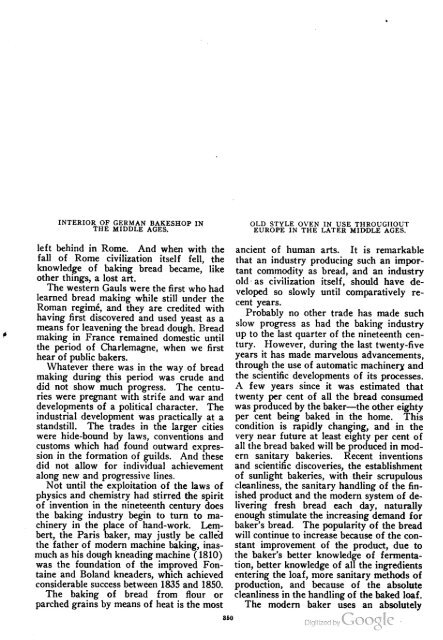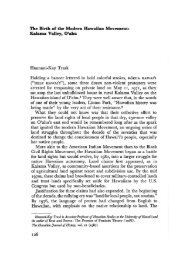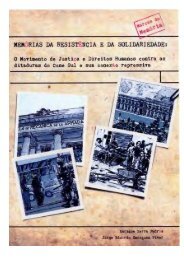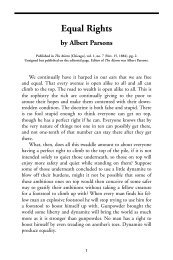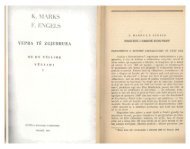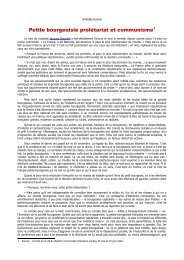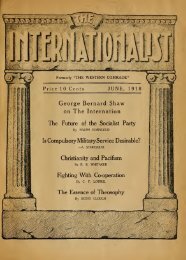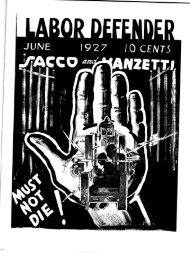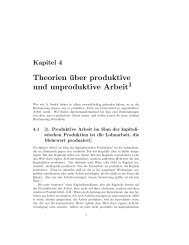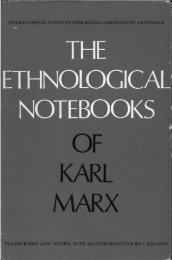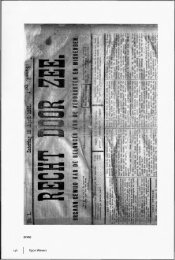- Page 1 and 2:
This is a digital copy of a book th
- Page 3 and 4:
» "1
- Page 5 and 6:
Digitized byGoo^k
- Page 7 and 8:
Digitized by Google
- Page 9 and 10:
:..: • By PROF. J, HOWARD MOORE A
- Page 11 and 12:
A Free Ford 5-Passenger Touring Car
- Page 13 and 14:
From the Masses. Army Medical Exami
- Page 15 and 16:
gates really had something to thres
- Page 17 and 18:
8 DOINGS OF THE MONTH the woman. "T
- Page 19 and 20:
10 DOINGS OF THE MONTH worked for h
- Page 21 and 22:
12 THE FLAG FOLLOWS THE INVESTOR im
- Page 23 and 24:
14 THE FLAG FOLLOWS THE- INVESTOR c
- Page 25 and 26:
16 THE INVISIBLE GOVERNMENT much co
- Page 27 and 28:
18 We have enough confidence in Con
- Page 29 and 30:
Industrial Unionism: A^/liat Is It?
- Page 31 and 32:
WHERE THIS picture shows how the pr
- Page 33 and 34:
24 THE LIES WE BELIEVE war with Mex
- Page 35 and 36:
IT &\ The House Fly as a Carrier of
- Page 37 and 38:
28 THE HOUSE FLY rial in concentrat
- Page 39 and 40:
30 IMPERIALISM ant element in the c
- Page 41 and 42:
32 have a common interest ; they al
- Page 43 and 44:
Digitized by Google
- Page 45 and 46:
36 HOW JIM HILL MADE HIS, MONEY "A
- Page 47 and 48:
38 TRIMMING THE FARMER value—beca
- Page 49 and 50:
40 TRIMMING THE FARMER the mill man
- Page 51 and 52:
WELL, ^Aforksliop Talks By JAMES CO
- Page 53 and 54:
44 INTERNATIONAL SOCIALIST REVIEW a
- Page 55 and 56:
46 ROBERT MINOR ture tae him : "Is
- Page 57 and 58:
INTERNATIONAL NOTES BY WILLIAM E. B
- Page 59 and 60:
50 INTERNATIONAL NOTES Rheumatism A
- Page 61 and 62:
52 INTERNATIONAL NOTES Bush Car Fre
- Page 63 and 64:
54 INTERNATIONAL SOCIALIST REVIEW W
- Page 65 and 66:
56 The Ancient Lowly A History of t
- Page 67 and 68:
58 NEWS AND VIEWS Big Opportmiily f
- Page 69 and 70:
60 NEWS AND VIEWS HOW THE FARMER CA
- Page 71 and 72:
62 INTERNATIONAL SOCIALIST REVIEW *
- Page 73 and 74:
Digitized by Google
- Page 75 and 76:
Classics of Science FREE With Revie
- Page 77 and 78:
A Free Ford 5-Passenger Touring Gia
- Page 79 and 80:
From the Masses Preparedness Gods 6
- Page 81 and 82:
Starrcn, in N Y. Tribunt. HENRY FOR
- Page 83 and 84:
72 DOINGS OF THE MONTH UNDER THE ST
- Page 85 and 86:
PARADE OF STRIKING IRON MINERS The
- Page 87 and 88:
A FAMILIAR SCENE IN MIINNESOTA THES
- Page 89 and 90:
WmWemi&iifim&L *[ 196 tf&uui g*3*3
- Page 91 and 92:
INTERNATIONAL SOCIALIST REVIEW your
- Page 93 and 94:
82 ABOLITION OP PRIVATE PROPERTY An
- Page 95 and 96:
BY IN THE PINEAPPLE COUNTRY long od
- Page 97 and 98:
86 THE HAWAIIAN PINEAPPLE in size,
- Page 99 and 100:
years and was certain of success if
- Page 101 and 102:
90 'OUR" NATIONAL INSURANCE keen co
- Page 103 and 104:
92 'OUR" NATIONAL INSURANCE tives s
- Page 105 and 106:
94 INTERNATIONAL SOCIALIST REVIEW s
- Page 107 and 108:
THE LEFT WING The Passing of the Ol
- Page 109 and 110:
98 THE LEFT WING lame wing of the r
- Page 111 and 112:
100 FACE TO FACE 10. Little clear m
- Page 113 and 114:
102 THE DRONE they can. How long di
- Page 115 and 116:
Some Personal Reminiscences of Prof
- Page 117 and 118:
Henry Dutb on the Proposed Socialis
- Page 119 and 120:
The oldest and most primitive under
- Page 121 and 122:
110 THE ORIGIN OF MAN appears notch
- Page 123 and 124:
INTERNATIONAL NOTES BY WILLIAM E. B
- Page 125 and 126:
ta t 114 INTERNATIONAL NOTES TYPEWR
- Page 127 and 128:
ne INTERNATIONAL NOTES verj HjCOLD
- Page 129 and 130:
18 INTERNATIONAL SOCIALIST REVIEW .
- Page 131 and 132:
120 NEWS AND VIEWS the other ones.
- Page 133 and 134:
BOOK REVIEWS Carl Sandburg's "Chica
- Page 135 and 136:
124 ' INTERNATIONAL SOCIALIST REVIE
- Page 137 and 138:
126 INTERNATIONAL SOCIALIST REVIEW
- Page 139 and 140:
128 INTERNATIONAL SOCIALIST REVIEW
- Page 141 and 142:
A 5-Passenger 1917 Ford Touring Car
- Page 143 and 144:
130 INTERNATIONAL SOCIALIST REVIEW
- Page 145 and 146:
132 INTERNATIONAL SOCIALIST REVIEW
- Page 147 and 148:
Eugene V. Debs Digitized by^Google
- Page 149 and 150:
136 THE CLASS WAR AND ITS OUTLOOK T
- Page 151 and 152:
'/ 138 FLASHES ALONG THE BATTLE-LIN
- Page 153 and 154:
140 FLASHES ALONG THE BATTLE-LINE W
- Page 155 and 156:
A BUi.Y DAY FOR THE SHERIFF AND HIS
- Page 157 and 158:
Will Eugene V. Debs Sit in Congress
- Page 159 and 160:
A NEWSPAPER reporter tells a story
- Page 161 and 162:
148 THEY BELONG INSIDE as soon as t
- Page 163 and 164:
ISO PETROLEUM IN MEXICO 1 federal l
- Page 165 and 166:
152 MEXICAN CONGRESS by the workmen
- Page 167 and 168:
Going to School Thru Revolution By
- Page 169 and 170:
156 Diaz, with whom they could deal
- Page 171 and 172:
THE MESABA STRIKE By GEORGE P. WEST
- Page 173 and 174:
160 THE MESABA STRIKE have particip
- Page 175 and 176:
162 INVADING MINERS' HOMES to jail.
- Page 177 and 178:
164 SOCIALISM IN GERMANY forced to
- Page 179 and 180:
166 THE NEGRO AND THE WAR ing the l
- Page 181 and 182:
A BIG A WALKING EXCAVATOR excavatin
- Page 183 and 184:
CAN George Andreytckine the Steel C
- Page 185 and 186:
172 ON THE LID portant fact that th
- Page 187 and 188:
174 CAN THE UNIONS, WIN? worker on-
- Page 189 and 190:
176 THE DEBS CAMPAIGN paign manager
- Page 191 and 192:
INTERNATIONAL NOTES BY WILLIAM E. B
- Page 193 and 194:
80 INTERNATIONAL SOCIALIST REVIEW A
- Page 195 and 196:
1% IXTBRXATIOXAL SOCIALIST RFA'llli
- Page 197 and 198:
From the Masses PENNSYLVANIA COSSAC
- Page 199 and 200:
200 II'HY THE RAILS IVON Again let
- Page 201 and 202:
202 iniv run rails was the future a
- Page 203 and 204:
204 Ml'RDER /.V FIRST DEGREE more l
- Page 205 and 206:
POLITICS AND PEOPLE Knott, in Dalla
- Page 207 and 208:
208 WOMEN AS GUN MAKERS and the num
- Page 209 and 210:
KINGS, QUEENSAND HISTORY By GRACE F
- Page 211 and 212:
212 KINGS, QUEENS AND HISTORY a gre
- Page 213 and 214:
214 WHAT CAPITALISTS ARE SAYING for
- Page 215 and 216:
ONE THE SAN FRANCISCO FRAME-UP By R
- Page 217 and 218:
FOOT-PROPELLED VEHICLES THE dominat
- Page 219 and 220:
220 CRIME AND ECONOMIC CONDITIONS t
- Page 221 and 222:
222 INDUSTRIAL UNIONISM animals we
- Page 223 and 224:
AMONG the many excellent things whi
- Page 225 and 226:
PEOPLE MARY MARCY in America have o
- Page 227 and 228:
228 A MAN VS. TAXES {used to live u
- Page 229 and 230:
230 INTERNATIONAL SOCIALIST REVIEW
- Page 231 and 232:
232 AT THE MERCY OF THEIR EMPLOYEES
- Page 233 and 234:
234 MASS "ACTION This is most appar
- Page 235 and 236:
236 MASS ACTION stone or a gun, and
- Page 237 and 238:
238 THE RAILROAD WORKDAY previously
- Page 239 and 240:
240 INTERNATIONAL SOCIALIST REVIEW
- Page 241 and 242:
242 /XTLRXATIOXJL XUTliS work again
- Page 243 and 244:
244 INTERNATIONAL SOCIALIST RlirilU
- Page 245 and 246:
246 Slill'S sl.\ I) runt's SociaKsm
- Page 247 and 248:
248 INTr.RSATIOXAL SOCIALIST KnVIHW
- Page 249 and 250:
250 IX'lliNXAl IOSAL SOCIALIST HIU'
- Page 251 and 252:
THE THE SITUATION IN THE FIFTH DIST
- Page 253 and 254:
254 iXTHRX.-IT/OX.IL SOCIALIST Rlil
- Page 255 and 256:
UHV Burlington Watch Co. \ 19th Str
- Page 257 and 258:
I LB 1 { I ! 1KJI 1 [ IILBI [ 1^" U
- Page 259 and 260:
260 INTERNATIONAL SOCIALIST REVIEW
- Page 261 and 262:
A 5-Passenger 1917 Ford Touring Car
- Page 263 and 264:
Drawn by Robert Minor Kinm the Blas
- Page 265 and 266:
JOHN D. ROCKEFELLER WHILE John D. R
- Page 267 and 268:
268 PASSIVE RES/STANCE ON paper no
- Page 269 and 270:
270 MORE "LAW AND ORDER" more of de
- Page 271 and 272:
272 THE RAILWORKERS' "VICTORY' To t
- Page 273 and 274:
274 THE TALE OF THE MOVIE aried sto
- Page 275 and 276:
276 THE TALE OF THE MOVIE sends it
- Page 277 and 278:
278 HOW WE ROBBED MEXICO wards set
- Page 279 and 280:
280 THE CAMPAIGN FORECAST States an
- Page 281 and 282:
OKLAHOMA HOMES OF FREE BORN AMERICA
- Page 283 and 284:
A FAMILIAR RURAL SCENE IN OKLAHOMA.
- Page 285 and 286:
THE Tke Strike of New York Carmen B
- Page 287 and 288:
288 THE STRIKE OF NEW YORK CARMEN t
- Page 289 and 290:
290 THE STRIKE OF NEW YORK CARMEN "
- Page 291 and 292:
292 BUILDING A UNION AT 40 BELOW 10
- Page 293 and 294:
294 WHO PAYS THE TAXES went by afte
- Page 295 and 296:
296 WHO PAYS THE TAXES An employer
- Page 297 and 298: EIGHT CARLO TRESCA SAM SCARLETT JOS
- Page 299 and 300: 300 LEGAL SIDELIGHTS ON MURDER deny
- Page 301 and 302: 302 THE LEFT WING hands of the most
- Page 303 and 304: 304 THE GERMAN MINORITY knecht on D
- Page 305 and 306: 306 EDITORIAL left of the "competit
- Page 307 and 308: 308 EDITORIAL demanding of the big
- Page 309 and 310: 310 ki wrauusmt in mima m he sizul-
- Page 311 and 312: 312 INTERNATIONAL NOTES better spen
- Page 313 and 314: 514 INTERNATIONAL NOTES ited to the
- Page 315 and 316: NEWS AND VIEWS The Iron Miners of M
- Page 317 and 318: The National Labor Defense Counsel
- Page 319 and 320: Digitized by Google
- Page 321 and 322: EugeneV.Debs Says: "The People's Co
- Page 323 and 324: 324 INTERNATIONAL SOCIALIST REVIEW
- Page 325 and 326: 3fa idlemortam Joe mi Murdered by t
- Page 327 and 328: Digitized by Google Q O W 2; HM Oh
- Page 329 and 330: 330 THE MESABA IRON RANGE ticularly
- Page 331 and 332: 332 THE MESA BA IRON RANGE THE OLIV
- Page 333 and 334: 334 SWEETNESS—AND THE DARK sance.
- Page 335 and 336: 336 SWEETNESS—AND THE DARK It is
- Page 337 and 338: Gt^i Nine Snort Ones By MILITANT ET
- Page 339 and 340: FIVE The Voyage of the Verona worke
- Page 341 and 342: 342 THE VOYAGE OF THE VERONA Immedi
- Page 343 and 344: 344 THE VOYAGE OF THE VERONA p. m.
- Page 345 and 346: 346 THE INTERNATIONAL OF THE DEED m
- Page 347: 348 THE INTERNATIONAL OF THE DEED t
- Page 351 and 352: DELIVERY END OF TWO BAKER TRAVELING
- Page 353 and 354: 354 THE GENERAL STRIKE have been ri
- Page 355 and 356: THE THE SWISS MILITIA SYSTEM By WIL
- Page 357 and 358: 358 WHO OWNS THE UNITED STATES? mom
- Page 359 and 360: SAN Will Labor Stand for Another Ha
- Page 361 and 362: 362 ANOTHER HAYMARKET? which the La
- Page 363 and 364: 364 FROM GERMAN SOCIALISTS Parliame
- Page 365 and 366: 366 THE LEFT WING to win, but they
- Page 367 and 368: 368 EDITORIAL for us now to utilize
- Page 369 and 370: 370 INTERNATIONAL SOCIALIST REVIEW
- Page 371 and 372: 372 INTERNATIONAL NOTES Library of
- Page 373 and 374: 374 INTERNATIONAL NOTES MAKE V0UR O
- Page 375 and 376: 376 INTERNATIONAL SOCIALIST REVIEW
- Page 377 and 378: NEWS AND VIEWS How I Won the Ford.
- Page 379 and 380: 380 INTERNATIONAL SOCIALIST REVIEW
- Page 381 and 382: 82 INTERNATIONAL SOCIALIST REVIEW A
- Page 383 and 384: By PROF. J. HOWARD MOORE A new and
- Page 385 and 386: 86 INTERNATIONAL SOCIALIST REVIEW T
- Page 387 and 388: 888 .Digitized by CjOOgle
- Page 389 and 390: 390 "THE DREAM OF DEBS" fully and a
- Page 391 and 392: 392 "THE DREAM OF DEBS" what you fe
- Page 393 and 394: 394 'THE DREAM OF DEBS" wire-cuttin
- Page 395 and 396: DEATH MASKS OF THE MURDERED WORKERS
- Page 397 and 398: 398 REMEMBER THE FIFTH OF NOVEMBER
- Page 399 and 400:
400 OUR BENEVOLENT GOVERNMENT that
- Page 401 and 402:
Flashes Along tke Battle~Lme By MIL
- Page 403 and 404:
404 FLASHES of politics, palaver an
- Page 405 and 406:
NEFF, AGRICULTURAL WORKER TOOK twel
- Page 407 and 408:
408 THE TENTH ANNUAL BRAZIER, AGRIC
- Page 409 and 410:
AMONG the European Socialists, no h
- Page 411 and 412:
412 MASS ACTION IN RUSSIA strikes a
- Page 413 and 414:
SCENE IN THE CONGO COUNTRY Blacks a
- Page 415 and 416:
416. IN OKLAHOMA carry articles of
- Page 417 and 418:
Marxian Economics AN OUTLINE (Note:
- Page 419 and 420:
420 A SNARE OF THE ENEMY 6. What co
- Page 421 and 422:
WEnews from the White Pine for- ARE
- Page 423 and 424:
LIKE the giant trees that astonish
- Page 425 and 426:
Trie Present ^A^ar Crisis By WILLIA
- Page 427 and 428:
428 THE PRESENT WAR CRISIS ment has
- Page 429 and 430:
430 cheered when Tresca stood befor
- Page 431 and 432:
432 'THE DREAM OF DEBS" to be confi
- Page 433 and 434:
434 'THE DREAM OF DEBS" saddle, whi
- Page 435 and 436:
INTERNATIONAL NOTES BY WILLIAM E. B
- Page 437 and 438:
438 INTERNATIONAL NOTES plement eac
- Page 439 and 440:
NEWS AND VIEWS COMMODORE THEODORE L
- Page 441 and 442:
442 MEWS OF VIEWS —THE— Univers
- Page 443 and 444:
^s^^s Library of Science for the Wo
- Page 445 and 446:
446 INTERNATIONAL SOCIALIST REVIEW
- Page 447 and 448:
\S INTERNATIONAL SOCIALIST REVIEW.
- Page 449 and 450:
45^ SURE WE BELONG TO ONE BIG UNION
- Page 451 and 452:
NOON HOUR FEED AND 40* BELOW—f80
- Page 453 and 454:
Compulsory Arbitration m Australasi
- Page 455 and 456:
The Tkird International By ANTON PA
- Page 457 and 458:
462 LETTER FROM ABROAD necessitate
- Page 459 and 460:
464 LETTER FROM ABROAD lin—as if
- Page 461 and 462:
AN EXQUISITE SECTION OF BORO BOEDOE
- Page 463 and 464:
468 THE ISLE OF JAVA to seven p. m.
- Page 465 and 466:
SMOROE, 12,000 FEET ABOVE SEA LEVEL
- Page 467 and 468:
472 THE COST OF LABOR POWER cent up
- Page 469 and 470:
474 THE IRON HEEL IN AUSTRALIA Ther
- Page 471 and 472:
THREE days of the second week in Ja
- Page 473 and 474:
478 LOOKING 'EM OVER Man-power—be
- Page 475 and 476:
The Future of Socialism in America
- Page 477 and 478:
482 THE FUTURE OF SOCIALISM IN AMER
- Page 479 and 480:
484 MANIFESTO OF tary resources of
- Page 481 and 482:
uXrrr^^^i Under the Big Tops By A B
- Page 483 and 484:
488 UNDER THE BIG TOPS —for the c
- Page 485 and 486:
490 MARXIAN ECONOMICS the land owne
- Page 487 and 488:
NIGHT. Sleepyhead By ANTON TCHECKOF
- Page 489 and 490:
494 SLEEPYHEAD be to thrust her hea
- Page 491 and 492:
496 INTERNATIONAL NOTES Democracy.
- Page 493 and 494:
-Wo INTERNATIONAL SOCIALIST REVIEW
- Page 495 and 496:
500 NEWS AND VIEWS HOW 1 CURED MY C
- Page 497 and 498:
502 INTERNATIONAL SOCIALIST REVIEW
- Page 499 and 500:
PUBLISHERS' DEPARTMENT THE Annual S
- Page 501 and 502:
506 INTERNATIONAL SOCIALIST REVIEW
- Page 503 and 504:
Tke Most Interesting Library Club i
- Page 505 and 506:
510 INTERNATIONAL SOCIALIST REVIEW
- Page 507 and 508:
Jack London's Books Until Jack Lond
- Page 509 and 510:
HANDS ROUND THE WORLD 616 Digitized
- Page 511 and 512:
News from Nowhere By William Morris
- Page 513 and 514:
520 KILLED WITHOUT WARNING But bear
- Page 515 and 516:
522 KILLED WITHOUT WARNING without
- Page 517 and 518:
524 THE APOSTATE with coffee. The h
- Page 519 and 520:
526 THE APOSTATE to oppose the over
- Page 521 and 522:
" 528 THE APOSTATE kitchen. As he u
- Page 523 and 524:
530 WHOSE WAR? administration rushe
- Page 525 and 526:
532 WHOSE WAR? workers, who enlist
- Page 527 and 528:
THE Library of Congress is not only
- Page 529 and 530:
THE A HAND FULL OF LUMBER JACKS The
- Page 531 and 532:
538 THE LUMBER TRUST % So the wires
- Page 533 and 534:
540 THE STATE OF THE SOCIALIST PART
- Page 535 and 536:
ON Seeing Sarawak, m Borneo Peculia
- Page 537 and 538:
A DYAK ART GALLERY Every house has
- Page 539 and 540:
a livelihood. One tribe, the Sibus,
- Page 541 and 542:
548 ONCE OVER reporters, Will Irwin
- Page 543 and 544:
The Future of International Sociali
- Page 545 and 546:
THE men who build the railroads, la
- Page 547 and 548:
554 INTERNATIONAL SOCIALIST REVIEW
- Page 549 and 550:
556 CURRENT AFFAIRS note, is provin
- Page 551 and 552:
S58 (Continued from page 528) of th
- Page 553 and 554:
560 THE APOSTATE to work. The forem
- Page 555 and 556:
to2 INTERNATIONAL SOCIALIST REVIEW
- Page 557 and 558:
564 AN INTERNATIONAL POLICY >not th
- Page 559 and 560:
566 AN INTERNATIONAL POLICY years a
- Page 561 and 562:
INTERNATIONAL NOTES BY WILLIAM E. B
- Page 563 and 564:
INTERNATIONAL SOCIALIST REVIEW a or
- Page 565 and 566:
5/2 BOOK REVIEWS governments very q
- Page 567 and 568:
574 NEWS AND VIEWS this, of course,
- Page 569 and 570:
Digitized by Google
- Page 571 and 572:
578 Digitized by Google
- Page 573 and 574:
Copyright by Underwood & Underwood,
- Page 575 and 576:
Copyright by Underwood & Underwood,
- Page 577 and 578:
Copyright* by Underwood & Underwood
- Page 579 and 580:
586 FOOD RIOTS of Chicago, publishe
- Page 581 and 582:
FIVE SOULS By W. N. EWER First Soul
- Page 583 and 584:
590 THEIR COUNTRY For the mass of t
- Page 585 and 586:
592 THEIR COUNTRY in America, Germa
- Page 587 and 588:
594 THEIR COUNTRY It is not difficu
- Page 589 and 590:
596 conception of honor as have the
- Page 591 and 592:
I STREET SCENE IN CHINA Present-Day
- Page 593 and 594:
600 present-day china interrupting
- Page 595 and 596:
BUILDING THE UNION HALL steadily gr
- Page 597 and 598:
604 . THE ready for real fighting,
- Page 599 and 600:
606 MASS ACTION fers fundamentally
- Page 601 and 602:
608 MASS ACTION attached to the lab
- Page 603 and 604:
LETTER FROM KARL LIEBKNECHT By S. J
- Page 605 and 606:
612 LETTER FROM LIEBKNECHT saves hi
- Page 607 and 608:
614 TOM MOONEY lows, but they shall
- Page 609 and 610:
616 HAMSTRINGING THE SUGAR HOGS ing
- Page 611 and 612:
PLEDGE GIVEN TO NATION By American
- Page 613 and 614:
620 THE RUSSIAN REVOLUTION election
- Page 615 and 616:
622 MARXIAN ECONOMICS lands or let
- Page 617 and 618:
624 MARXIAN ECONOMICS lators come f
- Page 619 and 620:
626 EDITORIAL voices in a cry for "
- Page 621 and 622:
INTERNATIONAL NOTES BY WILLIAM E. B
- Page 623 and 624:
NEWS AND VIEWS Third Annual Encampm
- Page 625 and 626:
632 NEWS AND VIEWS the intellectual
- Page 627 and 628:
534 INTERNATIONAL SOCIALIST REVIEW
- Page 629 and 630:
36 INTERNATIONAL SOCIALIST REVIEW J
- Page 631 and 632:
638 PUBLISHERS' DEPARTMENT 36. The
- Page 633 and 634:
LEADERS: Why They Appear Why People
- Page 635 and 636:
Digitized by Google
- Page 637 and 638:
WHAT SHALL I DO WITH IT? Digitized
- Page 639 and 640:
646 THE RUSSIAN REVOLUTION Jones, i
- Page 641 and 642:
SHOP CONTROL By AUSTIN LEWIS THE wa
- Page 643 and 644:
Copyright by Underwood & Underwood,
- Page 645 and 646:
652 OUR GAINS IN THE WAR stand out
- Page 647 and 648:
654 MAN AND THE OTHER ANIMALS only
- Page 649 and 650:
656 MAN AND THE OTHER ANIMALS insti
- Page 651 and 652:
WHAT Darling, in the New York Tribu
- Page 653 and 654:
IF Will Marskall Field III. Enlist
- Page 655 and 656:
662 THE SHRUNKEN DOLLAR INFLUENCE O
- Page 657 and 658:
664 THE SHRUNKEN DOLLAR single loca
- Page 659 and 660:
our struggles for the emancipation
- Page 661 and 662:
workers were denied the rights of m
- Page 663 and 664:
Resolutions on War and Militarism T
- Page 665 and 666:
672 THE NATIONAL CONVENTION proposa
- Page 667 and 668:
674 THE EVERETT TRIALS ture and int
- Page 669 and 670:
676 TO THE SHAME OF LABOR The great
- Page 671 and 672:
678 ECONOMIC DETERMINISM classes ha
- Page 673 and 674:
680 A CHINESE CITY are wide benches
- Page 675 and 676:
682 MESSAGES FROM ABROAD war minori
- Page 677 and 678:
WHEN TO THE OLD GUARD By FRANK BOHN
- Page 679 and 680:
TO NEWS FROM NOWHERE those of us wh
- Page 681 and 682:
688 USEFUL NON-PRODUCTIVE WORKERS b
- Page 683 and 684:
INTERNATIONAL NOTES BY WILLIAM E. B
- Page 685 and 686:
692 INTERNATIONAL NOTES tions; plac
- Page 687 and 688:
694 NEWS AND VIEWS Library of Scien
- Page 689 and 690:
696 NEWS AND VIEWS John Spargo, Soc
- Page 691 and 692:
INTERNATIONAL SOCIALIST REVIEW wave
- Page 693 and 694:
30 INTERNATIONAL SOCIALIST REVIEW J
- Page 695 and 696:
702 INTERNATIONAL SOCIALIST REVIEW
- Page 697 and 698:
LLaIILIij. wky Pe°p,e _____ Fo||ow
- Page 700 and 701:
INTERNATIONAL SOCIALIST REVIEW VOL.
- Page 702 and 703:
INTERNATIONAL SOCIALIST REVIEW 711
- Page 704 and 705:
Digitized by Google
- Page 706 and 707:
THE Tlie Coming of Supernationalism
- Page 708 and 709:
Women Workers of Porto Rico By NINA
- Page 710 and 711:
load. - For this work they receive
- Page 712 and 713:
economic x Our Action Against Consc
- Page 714 and 715:
WHEN ZULUS ENJOYING A MULLIGAN NOTE
- Page 716 and 717:
which to go. He had to work all the
- Page 718 and 719:
INDUSTRIAL ACTION NEWS WESTERN UNIO
- Page 720 and 721:
THE SPRING DRIVE OF THE LUMBER JACK
- Page 722 and 723:
out a real organization among the m
- Page 724 and 725:
The Genealogy of Animals By J. HOWA
- Page 726 and 727:
much superior in flexibility to the
- Page 728 and 729:
BEFORE The Way That Failed the war
- Page 730 and 731:
Professional politicians discover a
- Page 732 and 733:
has been sent to the green sea weed
- Page 734 and 735:
trial conditions unchanged—then w
- Page 736 and 737:
INTERNATIONAL SOCIALIST REVIEW 745
- Page 738 and 739:
INTERNATIONAL SOCIALIST REVIEW 747
- Page 740 and 741:
ideological form under which it wil
- Page 742 and 743:
SOME EDITORIAL The Class Struggle D
- Page 744 and 745:
INTERNATIONAL NOTES BY WILLIAM E. B
- Page 746 and 747:
with all the various sorts of conse
- Page 748 and 749:
NEWS AND VIEWS May Day in Cleveland
- Page 750 and 751:
WhoGets$200,000,000TireProfits An a
- Page 752 and 753:
INTERNATIONAL SOCIALIST REVIEW 761
- Page 754 and 755:
INTERNATIONAL SOCIALIST REVIEW 763
- Page 756 and 757:
INTERNATIONAL SOCIALIST REVIEW 765
- Page 758 and 759:
TRUE, gospel truth, BUT did YOU eve
- Page 760 and 761:
Digitized by Google ^^p ^
- Page 762 and 763:
A . Digitized by Google I
- Page 764 and 765:
.> JUL ii 1 XOCi Digitized by Googl


